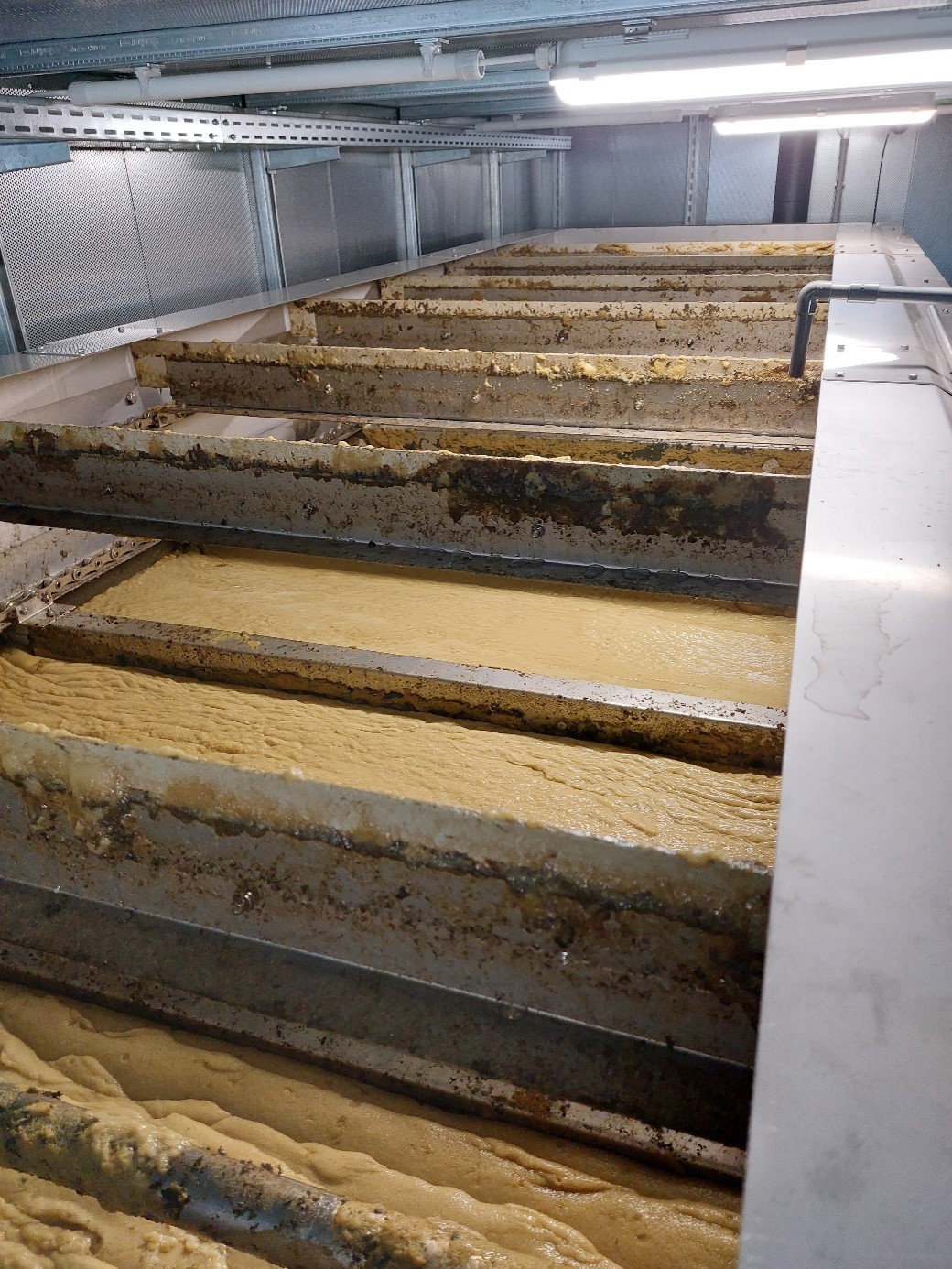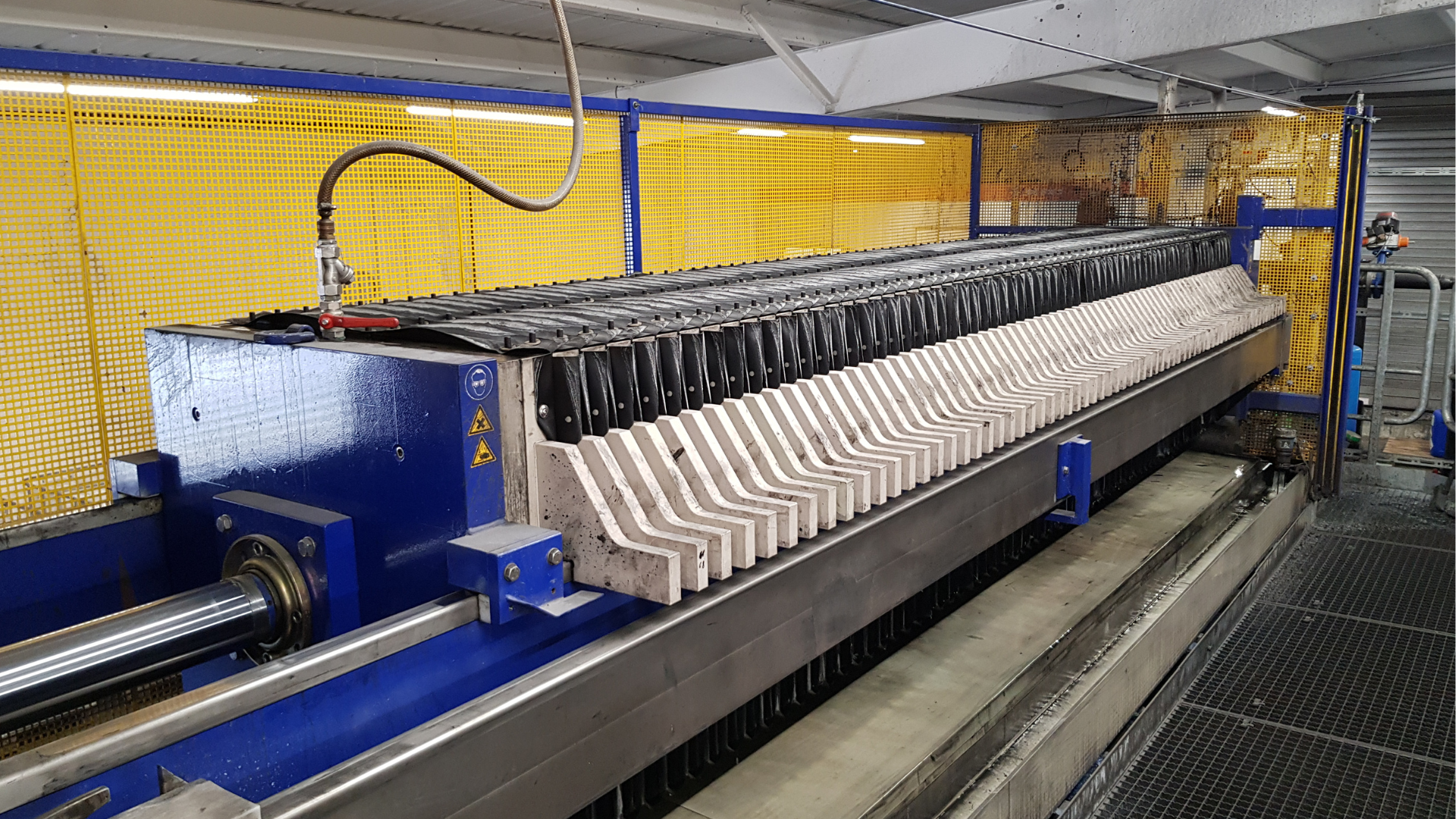The sludge treatment is a central component of water and wastewater technology. Sludge is a by-product of almost all water and wastewater treatment processes, whether in mechanical pre-treatment, precipitation and flocculation in CP plants or in biological treatment processes. It contains a mixture of water, organic and inorganic solids, as well as potentially hazardous substances such as heavy metals or pathogenic microorganisms. The aim of sludge treatment is to reduce its volume, recover valuable materials and enable safe disposal or recycling.
Table of contents
Origin and composition of sludge
Mud types
Depending on the source and the treatment process, a distinction is made between the following types of sludge:
- Primary sludge:
- Arises in mechanical wastewater treatment (e.g. through screens, grit chambers or primary clarifiers).
- High content of organic matter and suspended solids.
- Secondary sludge (biological sludge):
- Accumulates in biological processes (e.g. activated sludge process).
- Consists mainly of microorganisms (bacteria, fungi) and decomposed organic matter.
- Tertiary sludge (chemically precipitated sludge):
- Formed by precipitation and flocculation in CP plants, e.g. during phosphate removal or heavy metal reduction.
- Contains chemical residues (e.g. iron or aluminum salts).
- Industrial sludge:
- Waste product from industrial processes, often contaminated with toxic substances, heavy metals or organic pollutants.
Composition
The composition of sludge varies greatly depending on its origin and the treatment processes used:
- Water content:
- Raw sludge typically contains 95-99 % water.
- Organic substances:
- Main component of the sludge, e.g. cellulose, fats and proteins.
- Inorganic substances:
- Mineral components such as sand, silt and metals.
- Problematic substances:
- Heavy metals, pathogens (bacteria, viruses), organic pollutants (PAH, PCB).
Objectives of sludge treatment
Sludge treatment pursues several objectives that are based on legal requirements and operational requirements:
- Volume reduction:
- Reduction of the water content to minimize transport and disposal costs.
- Stabilization:
- Degradation of organic substances to prevent odors and putrefaction processes.
- Hazard minimization:
- Removal or immobilization of toxic substances such as heavy metals or pathogens.
- Resource extraction:
- Recovery of energy (e.g. biogas) or recyclable materials (e.g. phosphorus).
- Safe disposal:
- Compliance with the legal requirements for landfilling or thermal recycling.
Sludge treatment process
Sludge treatment comprises several stages, which are often used in combination. The most important processes include
1. thickening
Objective: Reduction of the water content in the raw sludge by separating solids and water.
- Gravity thickener:
- Use of sedimentation in large basins.
- Suspended solids settle at the bottom, clear water is separated at the top.
- Flotation:
- Enrichment of the sludge with fine air bubbles that bring particles to the surface.
- Centrifuges:
- Use of centrifugal force to separate solids and water.

Photo: Sludge thickening using our ALMA NeoDAF flotation plant
2. stabilization
Objective: Biological or chemical decomposition of organic substances to prevent odor formation and putrefaction.
- Anaerobic stabilization:
- Use in digesters under exclusion of oxygen.
- Organic substances are converted into biogas (methane, CO₂).
- Advantages: Energy generation through biogas production.
- Aerobic stabilization:
- Oxidation of organic substances through aeration.
- Often used in smaller systems or for low sludge volumes.
- Chemical stabilization:
- Addition of lime or other chemical agents to inhibit biological degradation processes.
3. sludge dewatering
Dewatering is a key step in sludge treatment and is used to reduce the water content in the sludge in order to reduce its volume and make further processing, transportation or disposal more economical. While raw sludge typically has a water content of 95-99%, dewatering can increase the solids content to 20-40%. This significantly reduces disposal costs and facilitates thermal utilization or drying.
Aim of sludge dewatering
- Volume reduction:
- A lower water content significantly reduces transportation and disposal costs.
- Improving drying efficiency:
- Dewatered sludge has a lower energy requirement for subsequent drying.
- Improved handling:
- The dewatered sludge becomes mechanically more stable and can be transported and processed more easily.
Drainage process
The choice of dewatering method depends on the type of sludge, the desired dewatering performance and the operational requirements. The most common methods include
Belt filter presses
The belt filter press is a mechanical dewatering technology that is widely used in municipal and industrial sludge treatment.
- Functional principle:
- The sludge is fed between two permeable belts, which are pressed together under high pressure.
- Water is pressed through the belts while the solids are retained.
- Process stages:
- Conditioning:
- Before dewatering, the sludge is treated with flocculants (e.g. polymers) to facilitate the separation of water and solids.
- Gravity drainage:
- In the first phase, the water flows through the belts under the force of gravity.
- Press zone:
- The sludge passes through several rollers that gradually increase the pressure to further squeeze out the water.
- Conditioning:
- Performance features:
- Final solids content: 18-25 % DM (dry matter).
- Throughput: High, suitable for large sludge volumes.
- Advantages:
- Continuous operation with a high degree of automation.
- Low operating costs.
- Disadvantages:
- Large installation area required.
- Susceptible to interference from fibrous materials or coarse particles in the sludge.
Chamber filter presses
The chamber filter press is a discontinuous process that enables particularly high dewatering capacities.
- Functional principle:
- The sludge is pressed into closed chambers equipped with filter plates and filter cloths.
- High hydraulic pressure (up to 15 bar) forces the water through the filter cloths while the solids remain behind.
- Process stages:
- Filling phase:
- The chambers are filled with sludge.
- Pressing phase:
- The water is pressed out by hydraulic pressure.
- Emptying:
- After the pressing process, the chambers are opened and the dewatered sludge (filter cake) is removed.
- Filling phase:
- Performance features:
- Final solids content: 30-45 % DM.
- Very high dewatering performance, even for sludges that are difficult to dewater.
- Advantages:
- High dry matter content and compact design.
- Very efficient water separation.
- Disadvantages:
- Discontinuous operation, therefore less suitable for large volumes.
- High acquisition costs.
Screw presses
The screw press uses a rotating screw that presses the sludge through a conical sieve. The pressure increases as the screw rotates, forcing the water out.
- Functional principle:
- The sludge is transported through a tapered screw, whereby the pressure on the sludge increases.
- Water is discharged through the screen, while the dewatered sludge exits at the tip of the screw.
- Performance features:
- Final solids content: 15-25 % DM.
- Particularly suitable for fibrous or coarse sludge.
- Advantages:
- Compact design and low maintenance costs.
- Robust against fluctuations in sludge properties.
- Disadvantages:
- Lower dewatering capacity compared to filter presses.
Centrifuges
Centrifuges use centrifugal force to exploit the differences in density between water and solids and achieve effective separation.
- Functional principle:
- The sludge is accelerated at high speed (up to 4,000 rpm) in a rotating drum body.
- Water is pressed outwards by the centrifugal force, while the solids remain inside the bowl.
- Process stages:
- Feeding:
- The sludge is continuously pumped into the centrifuge.
- Separation:
- Solids and water are separated by centrifugal force.
- Discharge:
- The dewatered sludge is discharged via a screw conveyor.
- Feeding:
- Performance features:
- Final solids content: 20-30 % TS.
- Suitable for large volumes and continuous processes.
- Advantages:
- High throughput capacity and flexible adaptation to different sludges.
- Compact design.
- Disadvantages:
- High energy consumption and higher operating costs compared to presses.

Photo: Our ALMA CFP chamber filter press for dewatering precipitation sludge from CP systems
4. drying
Objective: Further reduction of the water content after dewatering.
- Solar drying:
- Use of solar energy in special drying halls.
- Thermal drying:
- Use of heat (e.g. from waste heat processes) to evaporate the water.
- Fluidized bed dryer:
- Efficient process for large sludge volumes, especially in industrial applications.
The challenges of sludge treatment
Fluctuating sludge composition:
- Industrial plants often produce widely varying sludges, which makes it difficult to standardize treatment processes.
High disposal costs:
- Landfilling and thermal recycling in particular are cost-intensive.
Compliance with legal requirements:
- Strict limits for heavy metals, organic pollutants and pathogens require complex and multi-stage treatment processes.
Conservation of resources:
- The pressure to recover resources such as biogas or phosphorus is growing, which requires additional investment in innovative technologies.
Innovative approaches in sludge treatment
Phosphorus recovery:
- Processes such as struvite precipitation enable the recovery of phosphorus from sludge, which promotes its use as a fertilizer.
Improved drying technologies:
- Utilization of waste heat from industrial processes for energy-efficient sludge drying.
Combined processes:
- Integration of stabilization, dewatering and energy generation in a closed system.
Thermal hydrolysis:
- Pre-treatment of sludge to increase biogas production and improve dewaterability.
Conclusion
Sludge treatment is a complex process that requires a combination of mechanical and chemical processes. The aim is to reduce the volume of sludge safely, efficiently and economically and to recover resources. With the focus on sustainability and resource conservation, innovative technologies such as phosphorus recovery and thermal hydrolysis are becoming increasingly important. Optimized sludge treatment not only contributes to compliance with legal requirements, but also makes an important contribution to environmental protection and the circular economy.
For further information on our products, please feel free to contact us at any time!







